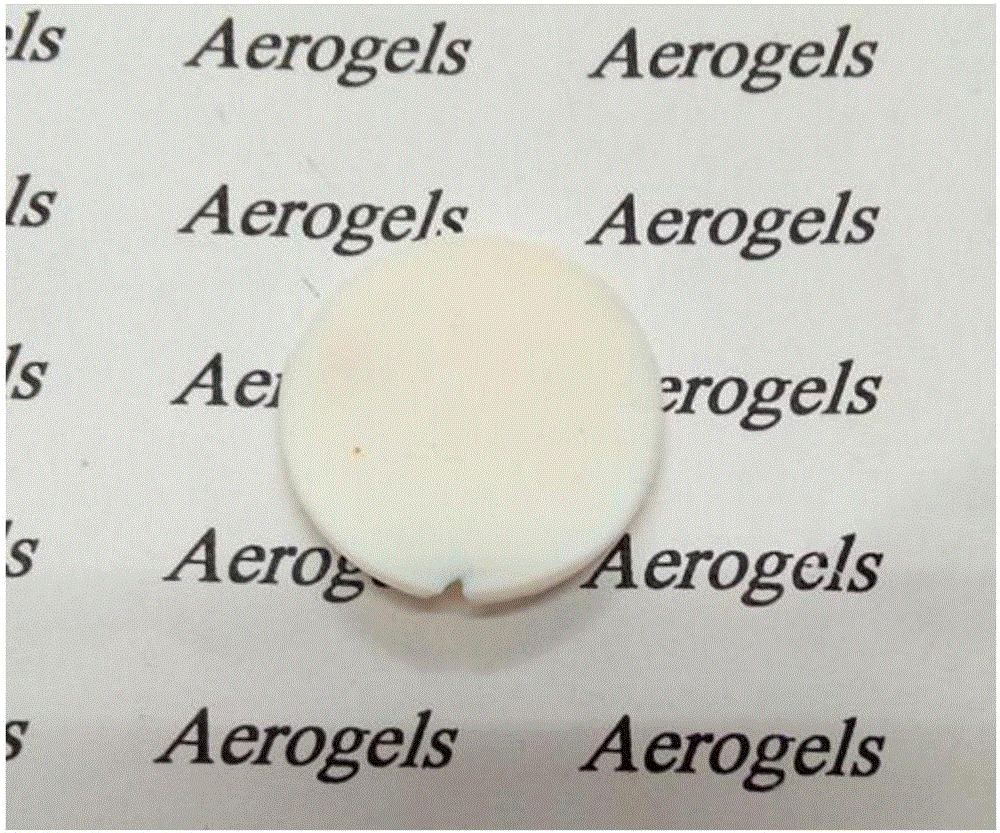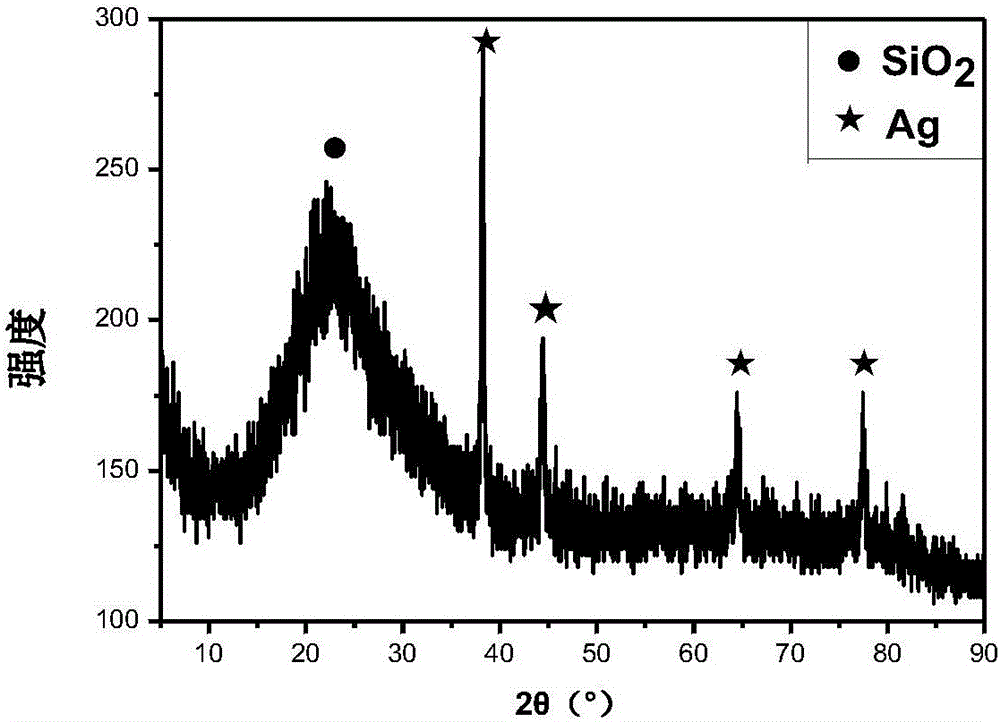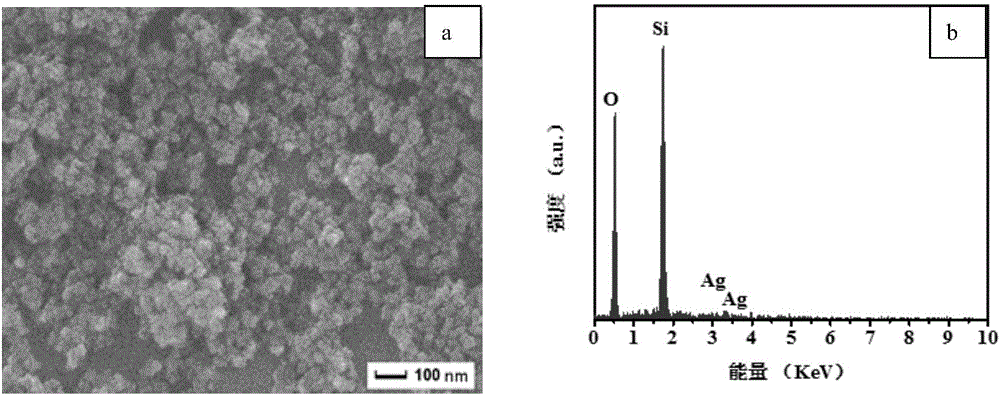Normal-pressure preparation method and application of block nanometer silver loading silica aerogel catalyst
A technology of silica and airgel, which is applied in the direction of physical/chemical process catalysts, chemical instruments and methods, catalyst activation/preparation, etc., can solve the problem of not meeting the requirements of green chemistry, the high price of silver nanoparticles, and the impact of agglomeration on catalytic performance and other problems, to achieve the effect of completely pollution-free synthesis process, good catalyst stability and good catalytic effect
- Summary
- Abstract
- Description
- Claims
- Application Information
AI Technical Summary
Problems solved by technology
Method used
Image
Examples
Embodiment 1
[0043] (1) At room temperature, measure 3mL of tetraethylorthosilicate, 4.5mL of acetonitrile, 2mL of deionized water in a beaker and stir it evenly, mark it as A; Measure 4.5mL of acetonitrile and 1mL of aminopropyltriethyl Stir the oxysilane in a beaker and mark it as B. The stirring time is 10 minutes. The mixed solution in beaker B is quickly added to beaker A and stirred for 10 minutes. When the solution has a turbid color, stop the stirring, take it out and let it stand until it returns to room temperature, and a wet gel will form. After aging at room temperature for 2 hours, 20 mL of acetonitrile was added for aging for 10 hours.
[0044] (2) Prepare 20 mL of acetonitrile solution of trimethylhexamethylene diisocyanate with a mass fraction of 10%, soak the wet gel with the prepared 20 mL solution, and place it in a water bath at 40°C for 24 hours.
[0045] (3) Take out the cross-linked gel, add 20 mL of acetonitrile, leave it at room temperature for 24 hours, seal it with a...
Embodiment 2
[0056] (1) Measure 3mL of tetraethylorthosilicate, 4.5mL of acetonitrile, 2mL of deionized water in a beaker and stir evenly, place in a mixture of ice and water, labeled A; Measure 4.5mL of acetonitrile and 1mL of aminopropyl Triethoxysilane was stirred evenly in a beaker and marked as B. The stirring time is 10 minutes. The mixed solution in beaker B is quickly added to beaker A and stirred for 10 minutes. When the solution has a turbid color, stop the stirring, take it out and let it stand until it returns to room temperature, and a wet gel will form. After aging at room temperature for 2 hours, 20 mL of acetonitrile was added for aging for 11 hours.
[0057] (2) Prepare 20 mL of acetonitrile solution of trimethylhexamethylene diisocyanate with a mass fraction of 10%, soak the wet gel with the prepared 20 mL solution, and place it in a water bath at 40°C for 24 hours.
[0058] (3) Take out the cross-linked gel, add 20 mL of acetonitrile, leave it at room temperature for 24 hour...
Embodiment 3
[0063] (1) Measure 3mL of tetraethylorthosilicate, 4.5mL of acetonitrile, 2mL of deionized water in a beaker and stir evenly, place in a mixture of ice and water, labeled A; Measure 4.5mL of acetonitrile and 1mL of aminopropyl Triethoxysilane was stirred evenly in a beaker and marked as B. The stirring time is 10 minutes. The mixed solution in beaker B is quickly added to beaker A and stirred for 10 minutes. When the solution has a turbid color, stop the stirring, take it out and let it stand until it returns to room temperature, and a wet gel will form. After aging at room temperature for 2 hours, 18 mL of acetonitrile was added for aging for 10 hours.
[0064] (2) Prepare 18 mL of a 10% mass fraction of trimethylhexamethylene diisocyanate in acetonitrile solution, soak the wet gel with the prepared 18 mL solution, and place it in a 40°C water bath for 24 hours.
[0065] (3) Take out the cross-linked gel, add 18 mL of acetonitrile, leave it at room temperature for 24 hours, seal ...
PUM
| Property | Measurement | Unit |
|---|---|---|
| Specific surface area | aaaaa | aaaaa |
| Hole radius | aaaaa | aaaaa |
Abstract
Description
Claims
Application Information
 Login to View More
Login to View More - R&D
- Intellectual Property
- Life Sciences
- Materials
- Tech Scout
- Unparalleled Data Quality
- Higher Quality Content
- 60% Fewer Hallucinations
Browse by: Latest US Patents, China's latest patents, Technical Efficacy Thesaurus, Application Domain, Technology Topic, Popular Technical Reports.
© 2025 PatSnap. All rights reserved.Legal|Privacy policy|Modern Slavery Act Transparency Statement|Sitemap|About US| Contact US: help@patsnap.com



